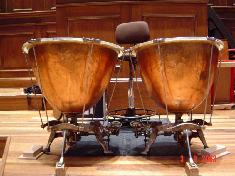
The
European
Timpani
GOAT
SKIN
GOAT
SKIN :
‘I
have experimented with skins of dog, sheep and calf. I have found dog and
sheep skins to be lacking harmonically; goatskin is stronger and more
harmonic, but a little harsh; the most preferable skin is that of
premature calves because it is more harmonic. It is, however, very
sensitive to atmospheric variations; this creates an inconvenience of no
little
importance. Added to this is
that it is difficult to find [and]
are rarely suitable because of
their insufficient size. Because of these problems, the best skin is
goatskin.’[1]-
Carlo A. Boracchi,
extract from his timpani method published in Italy in 1842.
It
should be said that the use of goat skin is relatively rare, however three
timpanists I spoke with while writing this paper were from the three
cities which have a strong tradition of using goat skin. They all use this
skin on a particular type of timpani, designed by Hans Schnellar, who was
at the end of the 19th century timpanist in the Tonhalle
Orchestra in Zürich, and the Concertgebouw Orchestra in Amsterdam, before
holding the same position with the Vienna Philharmonic for almost 40
years. All three of these orchestras continue with the tradition of
timpani sound and performance style which Schnellar bought to their
cities. Since Schnellar played with these three orchestras, their
timpanists have continued the tradition of playing on goat skin stretched
over deep, egg-shaped kettles, for more than a century. Schnellar's
influence spread from the Philharmonic throughout Vienna and now
timpanists in many orchestras in this city can be seen using his unique
design of timpani.

Schnellar
pedal timpani of the Royal Concertgebouw Orchestra
Again
it is not for reasons of tradition alone that the sound of goat skin can
still heard in these orchestras, but also the uniqueness in both
orchestral sound and concert hall acoustics of each ensemble. Dieter Dyk
explains : ‘These
three cities are very well known because of their famous concert halls!
Tohalle in Zürich, Concertgebouw in Amsterdam, and Musikvereinssaal in
Vienna. For
a long time, they were the three best in Europe. Schnellar has been
solo-timpanist in all three places. It is a fact, that these three famous
orchestras have a very strong tradition, and they are proud of their
special warm but not heavy sound, and they keep on with the Schnellar-timpani
tradition. As far as I know, the only three in Europe, if not in the
world. Somehow we have the same approach to the music.’
The
Viennese timpani (as Schnellar’s drums are known) share an important
property with the baroque timpani, an instrument also often found with a
goat skin head : their kettles are “free
ringing”. This is because of their tuning mechanisms – the baroque
with individual hand turned screws and the Viennese drums where the kettle
is pushed upwards onto the skin. In particular the goat skin is well
suited to the Viennese timpani; it is sharpened, but thinning is not
necessary because, with the smaller diameters of these drums, the tension
on each skin is less.[2]
Gerald
Fromme – ‘The lips of
Hochrainer-bowls don’t hang in a rim, they move up and down while
tuning. There are no unnecessary materials like push-rods or other things
around the bowls therefore they sounds free and friendly.’
But
for all of this, the history, the tradition of goat skins aside, why do
timpanists choose this skin, what can it do that the calf skin cannot? The
timpanists who use goat skin see it as having a warmer sound, which blends
more easily with the timbres of the orchestra, but other players have the
same opinions about calf.
Marinus Komst, solo timpanist with the Royal Concertgebouw
Orchestra, thinks that goat skins retain their qualities for a longer
period of time than calf skins; the skin does not become thinner and
lighter in colour to the point where it is almost see-through around the
playing area, as calf is prone to after long periods of use. He says also
that the sound of calf skin can be too soft and round for some repertoire.
Dieter
Dyk - ‘I prefer goat, because it
is more easy to play – the roll for example - it keeps the tuning
better, is dryer in our overwhelming acoustic, lives longer, costs
less!’
A
final point to mention is that the thicker goat skin requires a harder
mallet covered with flannel – whereas on calf skins the felt mallet
produces the best sounds. A different technique is used to play these
drums creating a sound which blends more with the sound of the orchestras
who use this type of drum, particularly in the case of the orchestras of
Amsterdam, Zürich and Vienna, performing in their unique halls. So
everything is interconnected, and one causes the other while being
influenced by another.